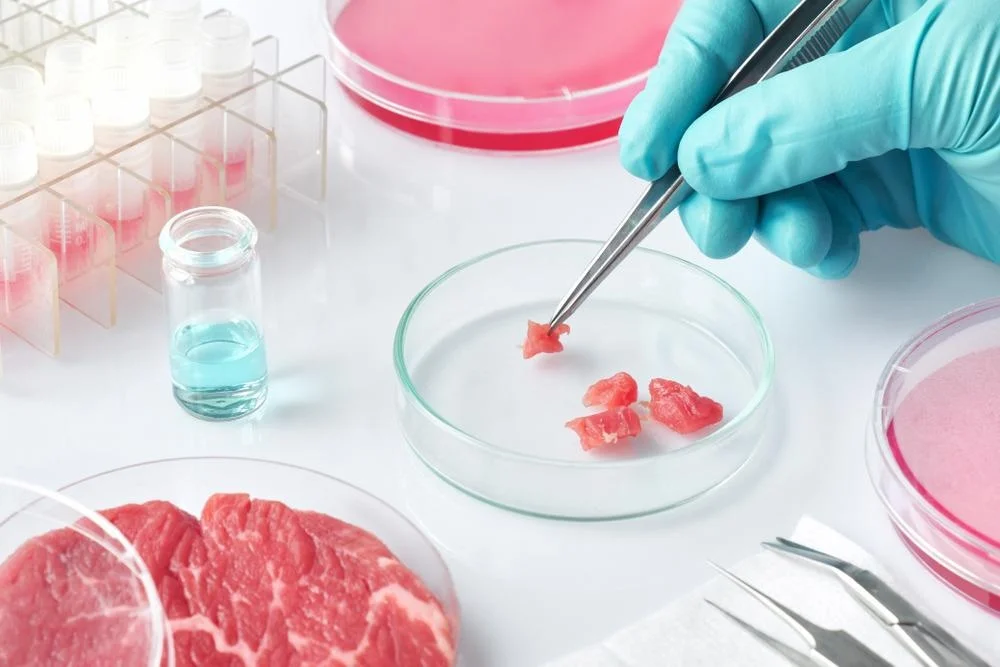Before moving forward to why lab-grown meat is bad? let’s first start with what is Lab-grown meat actually? well Lab-grown meat also known as cell-based or cultured meat. It is a scientific revolution based on change the way we consume and produce animal products. The main purpose of lab-grown meat is to solve major issues of traditional livestock farming like ethical, environmental, and sustainability problems.
Lab-grown meat does have some benefits, however people are concerned about its side effects and impact on overall human health, the environment, and our culture. In this article, we will dip into details of lab-grown meat by discussing how it is made, its potential benefits, and why some experts believe it could be problematic.
What is Lab-Grown Meat?
A meat that is made by cultivating animal cells in a lab known as lab-grown meat, instead of getting meat by raising and slaughtering animals. The process of making lab-grown meat includes taking a small sample of cells from an animal, putting the cell into a controlled condition in order to grow muscle tissue, which can be later used as meat. This method is known as an alternative to the old traditional animal farming process, also this method considers a more sustainable and ethical modern way to get meat. The goal is to provide the same texture, taste, and nutritional content as conventional meat without the need to raise and slaughter animals.
Since it is just a start for lab-grown meat it is still getting hype and being a part of discussion as people are concerned about the side effects on human health by consumption of lab-grown meat whether it is a truly viable and safe alternative to traditional meat.
How Lab-Grown Meat is Made
The production of lab-grown meat involves a complex process that mimics the way muscles grow in animals. Below are the key steps involved in producing lab-grown meat.
Step 1: Cell Collection
The first of creating lab-grown meat includes getting samples of cultivated cells from a living animal. This process takes place by means of biopsy, which involves small samples of muscle tissue. The cell used in lab-grown meat is stem cells, which have the ability to differentiate into various types of cells, such as muscle cells, fat cells, and connective tissue. These cells are considered building blocks for cultivated meat.
Like the old animal farming and slaughter process the lab-grown meat doesn’t involve any kind of animal harmed or animal farming. It is good for the environment however, concerns about the long-term viability and sustainability of using stem cells from animals persist.
Step 2: Cell Cultivation
As the first step includes collecting cells from a living animal the second step is cell cultivation. This includes placing cells in a bioreactor, which works as a controlled environmental box or space that provides the necessary nutrients, temperature, and conditions for the cells to grow and multiply. This box or medium contains amino acids, sugar and other compounds that help in growth of a cell. Over time, the cell starts to grow and forms muscle tissue.
This cultivation process takes up to 7 to 8 weeks, depending on what type of meat is being produced and the specific cultivation techniques used. The most challenging thing in this lab-grown meat cell cultivation is to create a condition that works as a mimic to the natural growth of animal cells, by ensuring the meat is structural and in a good texture.
Step 3: Tissue Engineering
After collecting cells from a living animal and cultivating process now the third process is tissue engineering. The process takes place where the cells start to form tissue which look like meat, the cells are encouraged to differentiate into muscle fibers, fat cells, and other components necessary for creating the structure and texture of meat. A 3D structure known as scaffolds made from biodegradable materials help in cell growth based on an ideal shape and structure. These scaffolds provide a framework for the cells to adhere to and grow into tissue. It is a difficult task, many companies are still working on it.
Step 4: Harvesting
After completing all 3 processes, include the tissue grown into a desired size and shape, which take place by bioreactors. At this stage the meat is still in a raw form that is why additional processing is needed to make it good for consumption. The harvested tissue can be further processed into ground meat, steaks, or other meat products, depending on the desired final product.
Also Read: Exploring Joe Rogan Carnivore Diet: Tips, Benefits, and Long-Term Effects
Benefits of Lab-Grown Meat
Despite the challenges, lab-grown meat has several potential benefits that make it an attractive alternative to traditional meat production. Some of these benefits include:
Impact of Lab-Grown Meat & the Environment
Since the lab-grown meat process is done just in a small space in labs, it is praised in reducing the ethical and environmental impacts of meat production. As we know, the traditional farming process includes raising and slaughtering animals and also requires large amounts of land, water, and feed. The old methods are also responsible for deforestation, and soil degradation Whereas lab-grown meat do not harm animals, no need for large amounts of land and water reduce environmental pressures by using fewer resources and producing less waste.
Positive Environmental Impacts
- The lab- grown meat production can lower the carbon footprints associated with traditional livestock farming. The old method of farming required a large amount of global greenhouse gas emission that is methane, which takes place by being released by ruminant animals like cows whereas lab grown meat doesn’t require a whole space like land so there is no methane gas taking place.
- Traditional meat involves a large amount of land for raising and slaughtering animals whereas lab grown meat requires less space and less water since this process takes place in a small medium or box based on a controlled environment. It reduces the risk of deforestation and minimizes the impact on natural ecosystems.
- Another positive impact of lab grown meat is it doesn’t require slaughtering or harm to any living animal just for the sake of food, like the old traditional animal farming methods. All the process needs is just taking cells from a living animal. This could be a significant step forward in promoting animal welfare.
Potential Negative Environmental Impacts
- As there are many positive impacts of lab grown meat on our environment there are also some negative impact. The production of lab grown meat takes place by consuming a lot of energy which means a large amount of electricity is required for cell cultivation. As the industry scales up, it is crucial to ensure that the energy used in the production process comes from renewable sources to avoid negating the environmental benefits.
- Additionally, the medium used to cultivation of cells are extremely expensive and take place from animal products such as fetal bovine serum so you can say it is a expensive and cost effective process.
Lab-Grown Meat and Human Health
Lab-grown meat has the potential to improve human health in some ways, but it also raises several concerns that need to be addressed.
Potential Health Benefits
According to some recent studies on the internet, Lab-grown meat can reduce the risk of some major diseases that jump from animal to humans via intake of meat. Since lab-grown meat is produced in sterile, controlled environments, there is less risk of contamination from pathogens like E. coli, Salmonella, or mad cow disease.
Lab-grown meat is full of nutritional profile, as it is produced in a small container or medium which is full of nutrients like omega-3 fatty acids, or a lower content of unhealthy saturated fats. This could lead to healthier meat options for consumers.
Potential Health Concerns
Lab-grown meat have many benefits for our health and it is good for our environment by reducing risk of traditional farming methods but the consumption of meat on long term basis do have side effects which are still unknown. This meat takes place by means of technology not by natural methods so It is still needed to study to fully understand how it can affect overall human health.
Another drawback of lab grown can be the cell, since the growth of cells takes place by using different chemicals. These chemicals may be used in small amounts but can be bad if you consume this meat for a long time.
The Importance of Meat in the Human Diet
The history of meat and humans is quite old and traditional, meat has been a fundamental part of the human diet for many decades. Meat is full of nutrients like protein, iron, vitamins and fats which play a very important role in overall human health. However, the way we produce and consume meat has evolved, and there are growing concerns about the environmental and ethical implications of traditional meat production.
In many cultures which are following from many centuries, meat is not only a dietary staple but also plays an important role in social rituals, celebrations, and traditions. In some cultures meat consumption is deeply rooted in history and still today meat is a part of their identity and lifestyle.
Since meat is full of nutrients, it is also important to consume it in a moderate amount for a balanced diet. If you consume meat in a large amount it can lead to some serious health concerns like health problems, including heart disease, cancer, and diabetes. A diet that includes a variety of plant-based foods, along with moderate portions of meat, is generally considered the healthiest approach.
Conclusion: Why Lab-Grown Meat is Bad?
While lab-grown meat has the potential to address some of the challenges associated with traditional meat production, it is not without its concerns. The technology is still in its early stages, and there are numerous issues related to its environmental impact, health risks, and social acceptance. The high energy requirements, reliance on animal-based growth mediums, and uncertainty regarding long-term health effects all contribute to the case against lab-grown meat.
Also Read: Do Bull Testicles have Vitamin A? Nutritional Facts and Benefits


